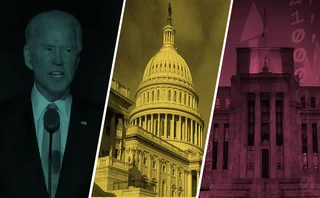
Conduct risk, CCP defaults and bitcoin futures
The week on Risk.net, January 27-February 2, 2018

Banks wrestle with conduct risk capital add-ons
Conduct risk-related additions to Pillar 2 capital raise questions over scope of UK’s Senior Managers Regime
CCPs should pay twice into default waterfall, say researchers
Chicago Fed paper calls for contributions in two phases: before members’ capital is tapped and after it is depleted
Exchanges defend self-certification at CFTC meeting
Listing of bitcoin futures has led to calls for more transparency on new contracts
COMMENTARY: Reining in the exchanges
Bitcoin continues to create a good deal of lively news-flow. January saw the launch of bitcoin futures by the Chicago Mercantile Exchange and the CBOE Futures Exchange (CFE). It also saw the price of the underlying plunge from a high of $16,815 in early January to $8,300 on February 2. The launch of the futures contracts was surrounded by controversy, and not just because of bitcoin’s infamous volatility; critics also pointed out that the contracts were based on prices at only a few bitcoin exchanges, which are largely unregulated and open to possible manipulation.
Those critics haven’t gone away, and they have been joined by many leading futures commission merchants (FCMs). Before the contracts were launched, the FCMs were making their concerns public; both exchanges had set high initial margin rates for the contracts – 27% at the CME and 33% at the CFE – and raised them even further before launch to 47% and 44% respectively. Many FCMs believed even this was too low, and introduced their own top-up margin requirements for their customers. They now argue the process through which the contracts were approved for trading – self-certification – was rushed through by two exchanges desperate to match each other, and that it left the clearing members taking risks they had never been given the chance to discuss.
The exchanges pushed back, saying a formal process of allowing FCMs to comment on new contracts before they are approved would be an unnecessary industry burden. Regulators seem divided on the issue, but it is possible bitcoin could be the trigger for an overhaul of how risks are handled at for-profit central counterparties (CCPs).
Most CCPs currently follow the same sequence of payments after a member default – known as a default waterfall. The defaulting member’s margin payments and contribution to the shared default fund go first. Next, the CCP itself pays out a tranche – its ‘skin in the game’, intended to provide it with an incentive for cautious risk management – and then the other clearing members’ parts of the default fund are paid out. If all that isn’t enough, the CCP can levy additional contributions from its members.
But the size of a CCP’s contribution varies greatly among CCPs. Recent research even suggests two tranches rather than one might be preferable. Gauging the correct size of CCP contribution is far from easy. Too small, and it has no incentive to improve its risk management, as the clearing members will absorb most of any loss (this is the situation some members say applies to the bitcoin futures at CME and CFE). Too large and the cost of capital will make fees prohibitive, and the incentive for clearing members to help take on portfolios to reduce the impact of a default will be lessened.
STAT OF THE WEEK
A task force convened by the European Systemic Risk Board has found eurozone banks hold only 17% of eurozone sovereign bonds and just 11% of the area’s supranational issuance. Philip Lane, chair of the task force, noted supranationals are favoured heavily by non-eurozone investors, who do not necessarily have the expertise to analyse individual sovereign creditworthiness, and they might be attracted to sovereign bond-backed securities for similar reasons. Hence, he concluded, overall demand for the senior tranche did not depend on prudential reform.
QUOTE OF THE WEEK
“I think there could almost be a benefit in there being no clear direction from politicians in the scenario that [Brexit] transition fails, because at that point you could have regulators step in and do what they want” – Risk manager at a large UK bank
Further reading
Only users who have a paid subscription or are part of a corporate subscription are able to print or copy content.
To access these options, along with all other subscription benefits, please contact info@risk.net or view our subscription options here: http://subscriptions.risk.net/subscribe
You are currently unable to print this content. Please contact info@risk.net to find out more.
You are currently unable to copy this content. Please contact info@risk.net to find out more.
Copyright Infopro Digital Limited. All rights reserved.
You may share this content using our article tools. Printing this content is for the sole use of the Authorised User (named subscriber), as outlined in our terms and conditions - https://www.infopro-insight.com/terms-conditions/insight-subscriptions/
If you would like to purchase additional rights please email info@risk.net
Copyright Infopro Digital Limited. All rights reserved.
You may share this content using our article tools. Copying this content is for the sole use of the Authorised User (named subscriber), as outlined in our terms and conditions - https://www.infopro-insight.com/terms-conditions/insight-subscriptions/
If you would like to purchase additional rights please email info@risk.net
More on 7 days in 60 seconds
Bank capital, margining and the return of FX
The week on Risk.net, December 12–18
Hedge fund losses, CLS and a capital floor
The week on Risk.net, December 5–11
Capital buffers, contingent hedges and USD Libor
The week on Risk.net, November 28–December 4
SA-CCR, SOFR lending and model approval
The week on Risk.net, November 21-27, 2020
Fallbacks, Libor and the cultural risks of lockdown
The week on Risk.net, November 14-20, 2020
Climate risk, fixing Libor and tough times for US G-Sibs
The week on Risk.net, November 7-13, 2020
FVA pain, ethical hedging and a degraded copy of Trace
The week on Risk.net, October 31–November 6, 2020
Basis traders, prime brokers and election risk
The week on Risk.net, October 24-30, 2020







